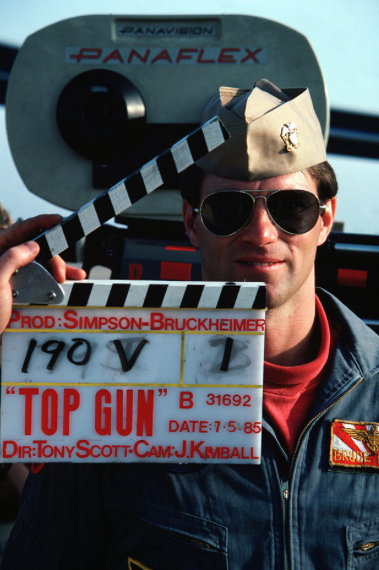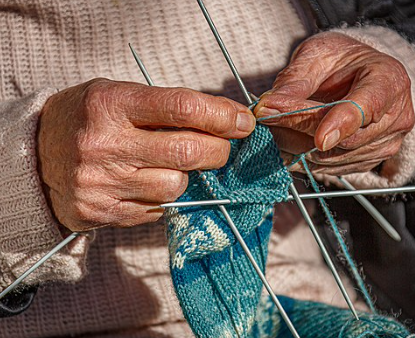Thirty-five years after he first clenched his jaw as a daring jet pilot in a tight white t-shirt, Tom Cruise is Top Gun again. The Jurassic world is back, 28 years after those dinosaurs first raked in millions at the movies. Nearly four decades after her song first soared into the charts Kate Bush is running Up that Hill again, and 1970s Swedish supergroup Abba is back in concert, albeit this time as avatars. The fashion-conscious are wearing low-rider jeans and platform boots and even the mullet is having a moment.
Nostalgia is the mood of the times and it’s making the big bucks.

Filming the movie Top Gun at Naval Air Station Miramar, California in 1985. A real US naval aviator assists filmmakers.
Frazzled and unsettled by war in Europe, by the unquenchable pandemic, the seeming fracture of civilised democracy in the US and the ominous tidings of climate change, people are looking back to easier times and the comfort of the familiar. Knitters are rediscovering patterns from the baby boomer years of last century, and the age-old tradition of tea and biscuits is resurgent, even if the bickies are now gluten-free.
Nostalgia can be warm and comforting, but psychologists warn that protracted retreats to the past can breed dissatisfaction with the present.
Susan Rees, a research professor of psychiatry at the University of NSW, says many Australians are finding it difficult to deal with the world’s on-going “multi-crisis”. “It’s hard enough just dealing with the pandemic because that’s huge and all-pervasive, and there’s no end to it seemingly, so we have to adjust,” she says, adding that financial anxiety and concern about the fast-changing global landscape compound the stress.
While resorting to nostalgia can be a useful panacea, eventually people should face life as it is, she says. They need to determine how best to deal with each situation, such as working out how best to avoid infection in a pandemic, or how to structure finances to dodge the worst of a recessionary economy. “If we spend too much time in the past it can become a chronic rumination and it also become toxic and disabling.”
Nostalgia can spring fromdisturbing motivations as well. Former US president Donald Trump’s Make America Great Again (MAGA) activists seem to long for their lost (and maybe largely fictional) youths: a time when minorities knew their place and women didn’t go to work, where sexual orientation was kept decently in the closet and a job was for life.
For many, though, nostalgia is simply an occasional mood of gentle reflection, and it can be a look-back to almost any era. The social media phenomena of Throwback Thursday and Flashback Friday – posting photos from decades ago – are wildly popular: the Throwback Thursday hashtag #tbt is one of the most often used on Instagram, with more than 592 million posts at last count.
Nostalgia, too, can drive a mood of mourning for lost joys. When Apple announced the death of the last version of the iPod in April, a generation of nostalgic music-lovers with memories of a thousand songs shoved in a pocket lamented its passing. The last iPod models in shops sold out in a flash.
For Australians of a certain age, the smell of Vicks Vaporub, or Perkins paste, or the coconut oil in tanning lotion, or the taste of fairy bread or a Fantale chocolate, or a chord from INXS or Hunters and Collectors can bring on a wave of gentle nostalgia, just as the madeleines in Proust’s multi-volume novel Remembrance of Things Pastbrought memories flooding back.
Tribute bands strumming their way across the nation are testament to the popularity of musical memories: Elton Jack, the Beatels and the Beatnix, the Thunderstruck AC-DC show, and Achtung Baby U2 salute the big names of the past.
Ian McFarlane, who wrote The Encyclopedia of Australian Rock and Pop, says it’s hard to work out whether the current resurgence of Kate Bush’s song Running Up That Hill is primarily due to younger generations hearing it for the first time, or to older listeners whose memories have been jolted into life. The song featured in the sci-fi-horror drama series Stranger Things – itself a homage to ‘80s classic slasher films. Bush told the BBC that she thought the track would get some attention, but not this huge response. “It’s so exciting,” she said. “But it’s quite shocking really, isn’t it? I mean, the whole world’s gone mad.”
McFarlane thinks the music of our youth will always spark emotion. “I still listen to a lot of music from when I was growing up,” McFarlane says. “For people who have listened to a lot of music over the years, we have so much stored up in that brain and when something ticks that folder in your brain, it is a comfort isn’t it? Serotonin or endorphins or something like that is released in the brain and you go, wow, I remember when I first heard that song, oh yes, I’ve got to listen to that again.”
Nostalgia works; nostalgia sells, he adds. “An older generation who might, for example, have seen Cold Chisel – if their kids have grown up and they’ve got them off their hands, they go out for a good night with the music they remember from when they were young gig-goers.”
Keen music fans of varying ages waited for hours to see Paul McCartney, now an astonishing 80, wow the crowd at the massive Glastonbury Festival in England in June. Naturally enough, he sang a number of the Beatles’ legendary hits including Hey Jude, Getting Better, Carry that Weight, and Let it Be – songs older nostalgic listeners might have first heard many decades ago, when they were young and the world seemed fresh and new.
But we can be nostalgic can be for far more recent memories too. Gen Z Grammy-winning superstar Olivia Rodrigo, 19, also took to the stage at Glastonbury, teaming up with British singer Lily Allen for a nostalgic rendering of Allen’s 2009 song “Fuck You”. Rodrigo dedicated the song to the five US Supreme Court justices who overturned the historic Roe v. Wade judgement which guaranteed American women the right to an abortion.
Meanwhile, the Rocky Horror Picture Show stage show and film from the 1970s is still screening – making it one of the longest-running theatrical releases in history. With a storyline that salutes the sci-fi and B horror movies that proliferated from the 1930s to the 1970s, Rocky refuses to get old. Everyone knows the lyrics: “It’s astounding. Time is fleeting, Madness takes its toll, But listen closely, Not for very much longer, I’ve got to keep control, I remember doing the Time Warp, Drinking those moments when the blackness would hit me, And the void would be calling, Let’s do the Time Warp again.”
In 2020, a 37-year-old US warehouse worker created his own time warp, recording a TikTok video while he was skateboarding to work (his truck had broken down), mouthing the lyrics to the 1977 Fleetwood Mac song Dreams as he rolled down the hill. His video was a sensation, bouncing the then four-decade old song back into the charts, and earning the skateboarder many millions of views, and along the way, a new truck. The song caught the imagination of baby-boomers who might have first heard it when Malcolm Fraser was prime minister of Australia, we were wearing flares and Rod Stewart and the Bee Gees were riding high in the charts.
Music therapists know that music from a specific period, usually the songs and tunes popular in the years between a person’s late teens and early 30s, are profoundly influential and can be therapeutically useful. The so-called “reminiscence bump” is a time when enduring personality traits are laid down and often when love and life-long friendships are found. Playing the music from that period of a patient’s life can bring up long-dormant memories and help clear the fog of dementia. These are the songs people know by heart, the tunes that trigger a warm feeling of youth and energy. A multi-million dollar research project is now underway to determine how home-carers can use this reminiscence bump music to soothe upset or aggressive patients with dementia.
Flavours, too, can be powerfully evocative. Vanessa Horton, Arnott’s ‘culinary chef’, says nostalgic Australians turned to the biscuits of their youth during the pandemic. “We’ve been around for 160 years and so we have lots of memories to tap into over that time, and we know that our consumers have been doing exactly that, taking solace in our bickies,” she says. The company published biscuit recipes during the pandemic so Australians stranded abroad could bake their own, and a gluten-free range provides a modern edge for comfortable reminiscing.
Comfort is needed in an increasingly uncertain world. Jon Stratton, an adjunct professor of cultural studies at the University of South Australia, says life now often feels unsafe – with both global upheaval and economic uncertainty in Australia.
“These are huge issues,” he says. “With the decline in religion, people are looking for other kinds of solace and the past offers that.” Even the switch to working from home has up-ended many people’s long-held expectations of the work/life balance, he says, and the rushing tide of technology can be over-whelming. On the flip side, this technology has given people the tools to enjoy nostalgia. “The past is so much easier to access now, with streaming services for film, television, music. There are YouTube clips dating back decades, providing accessible cultural items from the past.”
Streaming platforms like Netflix and HBO Max buy old favourites like the television series Friends and The Office which these days rank among the most-watched streamed series, often out-performing new series. Trading on this nostalgia, Friends – The Reunion was reportedly watched by an astonishing 29 per cent of US streaming households when it screened in May last year.
Fashion from the Friends era (1994-2004) is back. So-called Y2K fashion from around the turn of the century runs to low-rise cargo pants, bright midriff-baring tank tops, halter tops, and hair clips. Katie Somerville, senior fashion and textiles curator at the National Gallery of Victoria, says nostalgia has had an outsize influence in current trends. “Some people would never dream of seeking out something someone else has worn and is true vintage, but they might be very comfortable with nostalgia and (new garments) playing homage to a particular era,” she says.
Besides a yearning for the feel of earlier times, fashion enthusiasts are now more interested in buying and wearing vintage clothes for environmental reasons; they want to jump off the fast fashion roller coaster, Somerville adds.
She recently wore tartan, which made her think of school uniforms, and she wondered at the time whether it was an unfortunate fashion choice. But people took note of her outfit and liked the look, perhaps because it reminded them of decades past. “Sometimes it’s the most unexpected things that trigger nostalgic feelings,” she says. “Gumboots are another one.” Ankle height gumboots have become a minor urban phenomenon recently: no doubt largely because of the unseasonable rains of recent months but also, Somerville thinks, because of an association with childhood or country retreats.
 With much the same emotional mindset, keen knitters have been sifting through the archives of the National Library of Australia in search of interesting knitting patterns from the past. Kathryn Favelle, director of reader services, says knitting patterns are among the archives’ most searched items, along with births, deaths and marriages (for those more interested in family history; another type of nostalgia).
With much the same emotional mindset, keen knitters have been sifting through the archives of the National Library of Australia in search of interesting knitting patterns from the past. Kathryn Favelle, director of reader services, says knitting patterns are among the archives’ most searched items, along with births, deaths and marriages (for those more interested in family history; another type of nostalgia).
But decades-old knitting patterns are not easy and often assume a technical expertise and understanding that few knitters have these days. The patterns usually only come in one size, for instance, because the authors expected expert knitters could easily adjust the size to suit.
“It was an understanding that knitting was a skill that people had, they didn’t need to have it all explained to them, they had knowledge from their parents and grandparents about how to adjust patterns, they knew what the abbreviations meant without having to have them spelled out,” Favelle says. “But not everyone has a 36-inch bust any more – we’re bigger and taller and our shoulders are broader than the people the patterns were originally designed for.”
Given the interest, the library decided to recruit volunteers to rework the instructions for modern knitters, and the resulting suite of nostalgic patterns has recently been published as a book, Vintage Knits, which has almost sold out of its first print run.
“Being able to dip into old patterns for all that nostalgia dressing that we see, I think really has helped to revive knitting as a craft,” Favelle says. “And that idea of it being a slow craft as well; knitting, crochet, hand-sewing at home, all of those are things that you can do that go against the speed at which we’re living our lives.”

